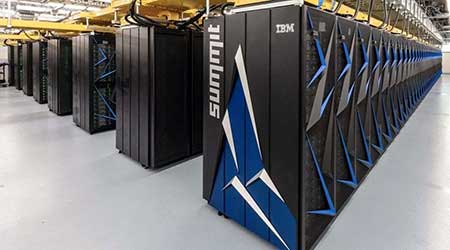Date : 31/05/2023
Relevance: GS 3: Awareness in the fields of Computers
Key Phrases: high-performance computing (HPC) system, Indian Institute of Tropical Meteorology in Pune, National Centre for Medium-Range Weather Forecasting, Mihir, Pratyush, Top500 Project, Centre for Development of Advanced Computing (CDAC), computational excellence.
Why in News?
- India's pursuit of supercomputing prowess continues as it prepares to install an upgraded high-performance computing (HPC) system, courtesy of French corporation Atos.
- This system, set to become India's fastest, is part of a deal signed by the government in 2018 to acquire high-performance computers worth ₹4,500 crores by 2025.
- Currently, India's prominent HPC machines, Mihir and Pratyush, operate at the Indian Institute of Tropical Meteorology in Pune and the National Centre for Medium-Range Weather Forecasting in Noida, supporting critical weather modelling efforts.
- However, the potential of these supercomputers extends beyond weather forecasting, calling for a comprehensive evaluation of their impact in diverse scientific fields.
National Supercomputing Mission (NSM):
- The Rs 4,500-crore project, launched in 2015, aims to create a powerful supercomputing capability in India.
- Led by the Ministry of Electronics and Information Technology and the Department of Science and Technology, the project is a joint effort with the Centre for Development of Advanced Computing (CDAC) and the Indian Institute of Science (IISc).
- The seven-year mission concluded in 2022, with the deployment of supercomputers such as PARAM Shivay, PARAM Shakti, PARAM Brahma, PARAM Yukti, and PARAM Sanganak.
- Currently India’s most powerful, civilian supercomputers are Pratyush and Mihir, with a combined capacity of 6.8 petaflops.
Supercomputing for Advanced Research:
- Driving Weather Forecasting:
- India's powerful supercomputers, such as Mihir and Pratyush, have played a pivotal role in advancing weather modelling.
- Accurate long-term monsoon predictions and daily weather forecasts depend on these sophisticated machines' ability to simulate complex atmospheric and oceanic conditions.
- The upcoming Atos machines will further enhance India's weather forecasting capabilities.
- Beyond Weather Modelling:
- While weather forecasting remains a vital application, supercomputers are crucial for addressing other challenging research questions.
- Fields like protein biology, aerospace modelling, and AI-linked applications heavily rely on high-performance computing.
- Supercomputers provide the computational power necessary for researchers to tackle complex problems and propel scientific advancements.
Supercomputers as Symbols of Technological Prowess:
- The Top500 Project:
- For over two decades, the Top500 project has maintained a list of the world’s most powerful HPC machines.
- Updated biannually, this list allows countries to showcase their technological advancements.
- Currently, India's highest-ranking machine, located at Pune's Centre for Development of Advanced Computing (CDAC), ranks in the top 100, boasting a top speed of 13 petaflops (1 petaflop = 1,000 trillion floating point operations per second).
- With the forthcoming Atos machines projected to reach 18 petaflops, India possesses multiple supercomputers in the petaflop range across various research institutions.
- Signifying Technological Prowess:
- The possession of powerful supercomputers serves as a medallion for countries seeking to establish their technological superiority.
- By prominently advertising their inclusion in the Top500 list, nations demonstrate their commitment to scientific advancement and computational excellence.
- India's growing presence on this list highlights its investment in supercomputing technology.
Maximizing the Potential of Supercomputers:
- Evaluating Breakthroughs in Science and Engineering:
- While possessing powerful supercomputers is an assurance that Indian scientists can tackle complex problems, it is essential to assess whether these machines have translated into significant breakthroughs in fundamental science and engineering commercial products.
- While India has leveraged supercomputers to improve short-term weather forecasts and cyclone predictions, their worth should be evaluated in diverse scientific domains beyond speed and power alone.
- Unlocking Cross-Disciplinary Collaborations:
- To fully harness the potential of supercomputers, interdisciplinary collaborations must be fostered.
- By encouraging researchers from various fields to explore the computational capabilities of supercomputers, India can drive innovation and make substantial contributions to fundamental science and the development of commercial products.
- The exploration of applications in protein biology, aerospace modelling, and AI-linked fields holds promise for unlocking new frontiers in scientific research.
Conclusion:
- India's upcoming high-performance computing system represents a significant step forward in the country's technological advancement.
- With Atos set to deliver an upgraded supercomputer, India's computational capabilities will increase further.
- While the current emphasis has been on weather modelling, it is essential to explore the potential of supercomputers in other scientific disciplines as well.
- By fostering interdisciplinary collaborations and encouraging research across diverse fields, India can leverage its supercomputing infrastructure to make significant contributions to fundamental science, engineering breakthroughs, and the development of commercial products.
Source: The Hindu
Mains Question:
Q. “Supercomputers have emerged as crucial tools for scientific research and technological advancements in various countries.” Discuss the significance of supercomputing in India, focusing on its application in weather forecasting and the need to explore its potential in diverse scientific disciplines.








